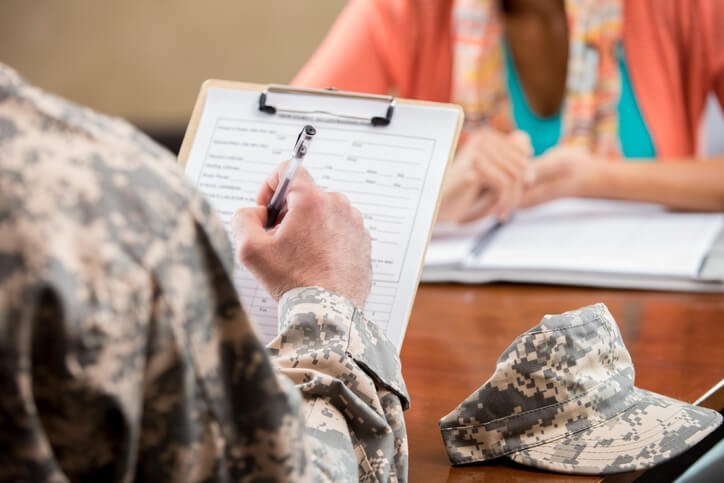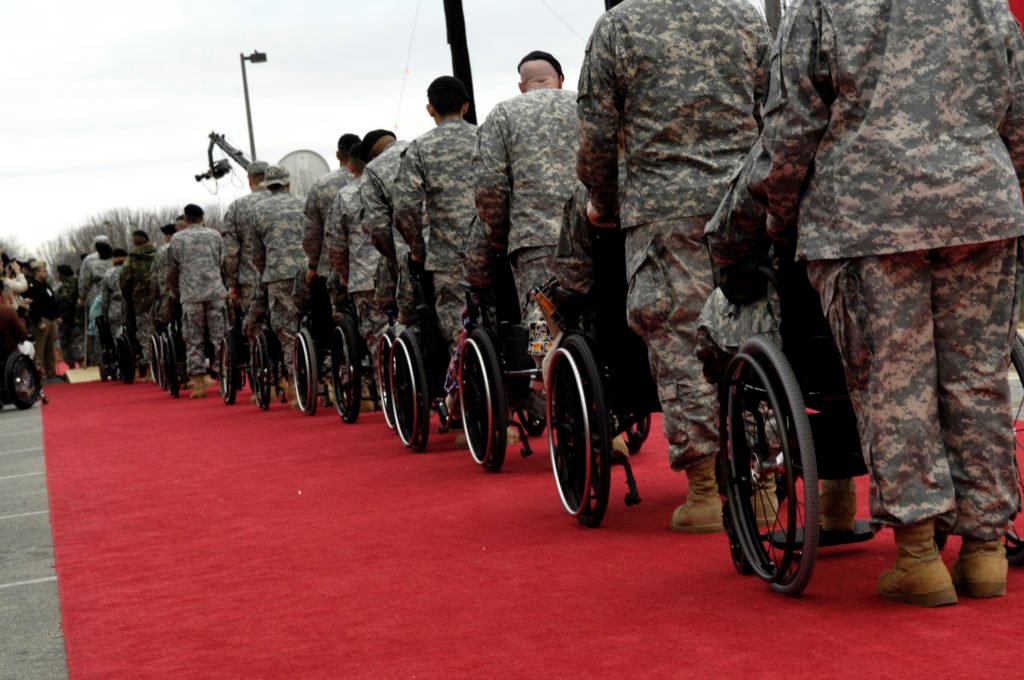VA Disability in the US
The men and women who serve in the Army, Air Force, Marines, Navy, and Coast Guard put their lives at risk to serve our nation every day.
Individuals who are injured as a result of their service to the country may be eligible for compensation for their injuries.
While people who are injured in other occupations often turn to the Social Security Administration for help, the military uses a different system to provide benefits to injured members; the Department of Veteran’s Affairs (or VA).
Individuals who suffer injuries in the service of the nation may find themselves dealing with the effects of the injury for the following years or decades. Some individuals find it difficult to work or maintain financial responsibility for themselves and their dependents.
Common injuries suffered in the line of duty are paralysis, loss of limbs and extremities, vision and memory problems, damage to motor skills, and other health issues that can have a major impact on the health of the individual for the rest of his or her life.
The Department of Veteran’s Affairs was established to make sure that the nation’s veterans are cared for in their time of need and that support is provided to help those who have been injured in the line of duty.
People who have been injured while serving in the Armed Forces may be eligible for benefits ranging from $100 a month to $3100 a month, depending on the specifics of their situation.
The amount of disability payments made per month to veterans who have been injured often depends on the severity of their disability and the number of dependents they can claim.
Disability benefit amounts may be increased due to loss of limbs, a significant number of dependents (including elderly or disabled parents), or a disabled spouse.
Veterans who feel they may be eligible for VA disability benefits should follow all of the steps of the application and typically are required to include medical records and doctor’s assessments regarding the injury.
The application also usually requires records identifying dependents, including marriage licenses and children’s birth certificates.
Applying for disability benefits can be very confusing for people who are unfamiliar with the process.

What Is A VA Disability Pay?
If you are a disabled veteran and are unable to work, then it is wise for you to apply for veterans’ disability benefits. In order to qualify for these benefits, you must have a disability that is service-related and be honorably discharged from military service.
Another eligibility requirement is that you served at least 90 days of active military service, including at least one day of service during a wartime period.
The amount you can receive varies considerably and ranges from just over $100 to more than $3000 per month. Disability compensation depends on a couple of things – how severe your disability is and how many dependents you have.
Other things such as loss of a limb, dependent makeup, and disabled spouse also come into play when your benefits are calculated.
About VA Disability Benefits
Veterans’ disability benefits are readily available for qualified military personnel. The military often denies disability claims but it does have an appeals process in place.
To appeal, you must complete a Notice of Disagreement. It is also advisable to hire an attorney at this point to increase your chances of being approved.
Disability Rates and Conditions
If you served your country and received a debilitating injury while on duty you deserve far more than just the condolences and admiration of the United States government.
The number of basic benefits paid ranges all depends on the type of disability.
VA determines the severity of one’s disability condition on the basis of the submitted evidence as part of the claim.
Or, that VA acquires military records for proof. The VA disability rates range from 0% to 100% in 10% increments (e.g. 10%, 20%, 30% etc.).
Please refer to the combined Rating section below for full information about the computation for disability percentage for multiple disabilities by the VA.
You may be paid additional amounts, in certain instances, if:
● You have very severe disabilities or loss of limb(s)
● you have a spouse, child(ren), or dependent parent(s)
● you have a seriously disabled spouse
It is the duty of the military to provide for its veterans, especially those that were injured. Your disability might be conflicting with your type of post-military work and may be made providing for yourself and your family close to impossible.
This should not be something you have to live with. There are veteran disability compensation programs that are meant to provide income and medical reimbursement for veterans who were injured while on duty.
Speak up for your rights and demand the compensation you deserve from the Veteran’s Affairs office closest to you.

Disability Pay Charts
Shown below is the Veterans Compensation Benefits Rate Tables that are very useful in calculating disability pay.
Rates (No Dependents): 10% – 20%
Basic Rates – 10%-100% Combined Degree Only
Effective 12/1/18
| Without Children | With Children |
| 30% – 60% | 30% – 60% |
| 70% – 100% | 70% – 100% |
10% – 20% (No Dependents)
| Percentage | Rate |
| 10% | $140.05 |
| 20% | $276.84 |
30% – 60% Without Children
| Dependent Status | 30% | 40% | 50% | 60% |
| Veteran Alone | $428.83 | $617.73 | $879.36 | $1,113.86 |
| Veteran with Spouse Only | $479.83 | $685.73 | $964.36 | $1,215.86 |
| Veteran with Spouse & One Parent | $520.83 | $739.73 | $1,032.36 | $1,297.86 |
| Veteran with Spouse and Two Parents | $561.83 | $793.73 | $1,100.36 | $1,379.86 |
| Veteran with One Parent | $469.83 | $671.73 | $947.36 | $1,195.86 |
| Veteran with Two Parents | $510.83 | $725.73 | $1,015.36 | $1,277.86 |
| Additional for A/A spouse (see footnote b) | $47.00 | $62.00 | $78.00 | $94.00 |
70% – 100% Without Children
| Dependent Status | 70% | 80% | 90% | 100% |
| Veteran Alone | $1,403.71 | $1,631.69 | $1,833.62 | $3,057.13 |
| Veteran with Spouse Only | $1,522.71 | $1,767.69 | $1,986.62 | $3,227.58 |
| Veteran with Spouse and One Parent | $1,617.71 | $1,876.69 | $2,109.62 | $3,364.37 |
| Veteran with Spouse and Two Parents | $1,712.71 | $1,985.69 | $2,232.62 | $3,501.16 |
| Veteran with One Parent | $1,498.71 | $1,740.69 | $1,956.62 | $3,193.92 |
| Veteran with Two Parents | $1,593.71 | $1,849.69 | $2,079.62 | $3,330.71 |
| Additional for A/A spouse (see footnote b) | $109.00 | $125.00 | $141.00 | $156.32 |
30% – 60% With Children
| Dependent Status | 30% | 40% | 50% | 60% |
| Veteran with Spouse and Child | $516.83 | $735.73 | $1,026.36 | $1,290.86 |
| Veteran with Child Only | $462.83 | $662.73 | $935.36 | $1,181.86 |
| Veteran with Spouse, One Parent and Child | $557.83 | $789.73 | $1,094.36 | $1,372.86 |
| Veteran with Spouse, Two Parents and Child | $598.83 | $843.73 | $1,162.36 | $1,454.86 |
| Veteran with One Parent and Child | $503.83 | $716.73 | $1,003.36 | $1,263.86 |
| Veteran with Two Parents and Child | $544.83 | $770.73 | $1,071.36 | $1,345.86 |
| Add for Each Additional Child Under Age 18 | $25.00 | $33.00 | $42.00 | $50.00 |
| Each Additional Schoolchild Over Age 18 (see footnote a) | $82.00 | $109.00 | $136.00 | $164.00 |
| Additional for A/A spouse (see footnote b) | $47.00 | $62.00 | $78.00 | $94.00 |
70% – 100% With Children
| Dependent Status | 70% | 80% | 90% | 100% |
| Veteran with Spouse and Child | $1,609.71 | $1,867.69 | $2,098.62 | $3,352.41 |
| Veteran with Child Only | $1,482.71 | $1,722.69 | $1,935.62 | $3,171.12 |
| Veteran with Spouse, One Parent and Child | $1,704.71 | $1,976.69 | $2,221.62 | $3,489.20 |
| Veteran with Spouse, Two Parents and Child | $1,799.71 | $2,085.69 | $2,344.62 | $3,625.99 |
| Veteran with One Parent and Child | $1,577.71 | $1,831.69 | $2,058.62 | $3,307.91 |
| Veteran with Two Parents and Child | $1,672.71 | $1,940.69 | $2,181.62 | $3,444.70 |
| Add for Each Additional Child Under Age 18 | $59.00 | $67.00 | $76.00 | $84.69 |
| Each Additional Schoolchild Over Age 18 (see footnote a) | $191.00 | $218.00 | $246.00 | $273.58 |
| Additional for A/A spouse (see footnote b) | $109.00 | $125.00 | $141.00 | $156.32 |
FOOTNOTES:
- Rates for each school child are shown separately. They are not included with any other compensation rates. All other entries on this chart reflecting a rate for children show the rate payable for children under 18 or helpless. To find the amount payable to a 70% disabled veteran with a spouse and four children, one of whom is over 18 and attending school, take the 70% rate for a veteran with a spouse and 3 children, $ 1786.71, and add the rate for one school child, $191.00. The total amount payable is $1918.71.
- Where the veteran has a spouse who is determined to require A/A, add the figure shown as “additional for A/A spouse” to the amount shown for the proper dependency code. For example, the veteran has A/A spouse and 2 minor children and is 70% disabled. Add $109.00, additional for A/A spouse, to the rate for a 70% veteran with dependency code 12, $1,668.71. The total amount payable is $1,777.71.
Source: benefits.va.gov
Disability Rating for PTSD – VA Veteran
What is PTSD?
The Department of Veteran Affairs Website defines Post Traumatic Stress Disorder as an anxiety disorder that can occur after you have been through a traumatic event.
A traumatic event is something horrible and scary that you see or that happens to you. During this type of event, you think that your life or others’ lives are in danger.
You may feel afraid or feel that you have no control over what is happening. They continue, stating that; Anyone who has gone through a life-threatening event can develop PTSD.
These events can include:
● Combat or military exposure
● Child sexual or physical abuse
● Terrorist attacks
● Serious accidents, such as a car wreck.
● Natural disasters, such as fire, tornado, hurricane, flood, or earthquake.
Overall, the more severe PTSD symptoms are, the higher the rating, and is based on the General Rating Formula for Mental Disorders.
The scales start between 0 – 100% including in-between ratings of 10, 30, 50, and 70%.

Disability Pay Dates
Those who received VA disability payments learned that they received a 2.8% raise in their benefits, which was the largest in 7 years.
Image Courtesy of military.com
Benefits are paid for a particular month on the first business day of the following month.
If the first business day of the month falls on a holiday or non-working day, benefits for the VA will be given on the last business day of the month.
VA Disability Calculator
Unfortunately, the most common hurdle veterans face when it comes to service-connected compensation claims they are quite different from that of the VA’s calculation. The ratings show otherwise, which makes the claim impossible to achieve, after a series of grueling accumulation of paperwork to support your disability.
For example:
If the VA determines your disability rating falls at 10 percent, then you are healthy by 90 percent.
What happens is that the next rating is used to take a percentage off of the ‘healthy’ 90%.
Off of a couple of 10 ratings, the first 10 percent would be off of 100% (10%); the second ten percent rating would be to take 10 percent off of the 90 percent, which is 9%.
In total, the combined rating would be 19 percent.
It’s rounded up to the nearest 10 percent, so in this case, it would be 20 percent.
Now, this is the most interesting part: the combined rating system begins to work against a claim as it gets near to 100%.
The rating over 50 percent and up gets more and more difficult each time. To know exactly what your percentage is, a disability rating calculator is used.
Disability Claims
How to Obtain Compensation
Any military service person that has a service-related disability and was discharged under other than dishonorable conditions can apply for disability compensation. This compensation can qualify you to receive between $123 and $3100 in monthly benefits.
You may be eligible to receive additional monetary benefits if you:
● Have very severe disabilities or loss of limbs
● You have a spouse, child(ren) or dependent parents
● You have a seriously disabled spouse
If you want to start the process of seeking veteran disability compensation, start by contacting your local Veteran’s Affairs office and filling out a VA Form 21-526EZ, Veterans Application for Compensation or Pension.
You should try to find and attach the following material to your application so you have a greater chance of being awarded benefits:
● Dependency records (marriage and children’s birth certificates)
● Medical evidence (doctor and hospital reports)
● Special Compensation for Certain Veterans
Certain veterans are able to apply for more substantial payouts if they are one of the following:
● A Prisoner of War
● A victim of diseases and cancers caused by agent orange or other herbicide exposure
● A sufferer of radiation exposure
● A Gulf War Veteran

Social Security Disability
The word “disability” has a very specific legal meaning under the Social Security laws.
To the average person, this can be confusing because Social Security’s definition may be different than the definition of disability under other disability laws and programs, such as worker’s compensation, temporary disability programs, long term disability insurance, special education programs, the Americans with Disabilities Act (“ADA”), the Department of Veteran Affairs, or the Division of Motor Vehicles definition when you obtain a handicapped plate.
In fact, what your treating doctor or therapist thinks is a disability may not be the same as Social Security’s definition.
In other words, even if you are considered disabled by another government agency, insurance program or medical professional, this does not always mean you are disabled for Social Security benefits.
If you are considering applying for disability benefits, you should not be discouraged by this information though because the fact that you were found disabled under some other program or by your own doctor may still be useful as partial evidence of your disability.
There are also non-medical and financial eligibility requirements for Social Security Disability Insurance (commonly referred to as “SSDI”, “SSD”, “Disability Insurance Benefits”, or “DIB”) and Supplemental Security Income (commonly referred to as “SSI”) benefits.
Generally, Social Security will consider you disabled for both SSDI and SSI benefits if you meet all of the following criteria:
1. You are not working or you are working but your earnings are limited (the earnings limit is set by the Social Security Administration, and for 2011, the limit is $1,640 if you are blind and $1,000 if you are not blind);
2. You have severe medical conditions that are expected to last for 12 months or more, or are expected to result in death;
3. Your severe medical conditions significantly interfere with your ability to work;
4. You can not perform the jobs you used to have; and
5. You can not learn how to perform other less physical jobs, even if you never had any other jobs in your life (for example, even if you never worked in an office before, if Social Security thinks you are able to meet the physical requirements of a file clerk and they think you can be retrained to work in an office, then you will not be considered disabled.).
You generally have to meet all of the criteria listed in order to be found a disability.
However, depending on the type of medical condition you have and its severity, you may be eligible for disability benefits even if you have the skills to perform certain types of jobs as long as your earnings are limited.
To apply for Social Security Disability you will need to schedule an appointment by calling Social Security’s toll-free number.
Your disability will be evaluated by an agency of the State you are currently residing; this evaluation typically takes 120 days to complete. If your application is approved you will start receiving disability payments after the mandatory five-month waiting period.
VA Disability Benefits in the US
There are many veterans in our country that have no idea that they could be receiving benefits. Some veterans feel that they do not have any reason to receive benefits and others upon being discharged would rather leave that life behind.
Plus, the laborious, seemingly endless application process can seem too daunting even to give it a try.
But, injured or disabled veterans have a right to benefits, and so should look into the process for obtaining them.
Even after they have been relieved of the burdens of war when they get home, these disabled veterans are forced to struggle in a new fight within themselves in claiming the disabled veteran benefits that the government has promised them and their families.
The current system possesses more than enough flaws to make it hard for these already disabled and aged veterans to get benefits such as hospital treatment.
Matters of red tape and delays are so abundant that even disabled veterans who manage to go through with the already tasking job of handling tons of paperwork for applying for benefits still find their efforts to be in vain because, more often than not, they end up with very little or nothing at all.
In hospitals, veterans are often overlooked and are not prioritized, forcing them to wait in line amongst relatively healthier and more capable patients when getting their check-ups.
The competence of those working in hospitals as well as offices concerned also cause inconveniences for veterans because of the uncommon cases of misplaced data or paperwork or failed transactions that cause delays of all kinds.
Even worse are those cases where disabled veterans are dismayed to find that they are rejected by government agencies because they were “unqualified” to claim these benefits.

Eligibility
Three main components make up a veteran’s possible eligibility for service-connected disability benefits.
First, you had to have served in the Army, Coast Guard, Navy, Marines, or Air Force.
Second, you must have a current disability, either caused by your time in the service or a disability that you had going into the service and it was aggravated or made worse by your time in the service.
There is a wide range of these sorts of disabilities, to some types of cancer, to breathing problems, to other disabilities that originated from or were affected by your service.
Third, you have to be able to connect your current disability to your time in the service.
How To Apply
Applying for veterans benefits requires that you complete VA Form 21-526EZ. This form, called the Veterans Application for Compensation or Pension, requires that certain information be included when you submit your application.
This information includes dependency records such as marriage licenses and birth certificates and medical records substantiating your disability.
You may also be asked to submit your discharge or separation papers. There is an online website, http://vabenefits.vba.va.gov/vonapp that you can use to apply or you can call toll-free at 1-800-827-1000 for further assistance.
A VA pension for veterans is available for wartime veterans who have a very small income or no income at all. To qualify, the veteran must be age 65 or older or under age 65 if permanently or fully disabled.
The Aid & Attendance and Housebound benefit bill allow some veterans to be paid additional money if they are very seriously disabled.
What Is The Aid & Attendance And Housebound Benefit?
Read on to know the basics of an oft-misunderstood VA pension benefit, the Aid & Attendance that is available for veterans and their widowed surviving spouses.
Wartime veterans and their surviving spouse with limited incomes, who are totally and permanently disabled for reasons not traceable to their service, may be eligible to receive compensation under the NSC (non-service connected) VA disability program.
There are two disability programs available through the VA that pays monthly benefits to disabled veterans. They are:
1. Disability Compensation (service-related disabilities)
2. Disability Pension (non-service related disabilities)
For the Disability Pension, there are three pension benefit levels. They are:
1. Disabled Veteran, unable to work
2. The housebound disabled veteran or surviving spouse
3. Disabled Veteran or surviving spouse who needs aid & attendance care

VA Veteran Disability Resource: Where To Contact
1) US Department of Veteran Affairs
2) VA Veteran Disability Benefits
https://www.ebenefits.va.gov/ebenefits/contact-us
3) Veterans Disability Benefits
https://www.ebenefits.va.gov/ebenefits/contact-us
4) Disabled American Veterans
Conclusion:
People who suffer from disabilities that prevent them from working and supporting themselves in an effective manner may be eligible for assistance from the government to help them pay for bills, rent, groceries, and other necessities. Individuals who suffer from birth disabilities, work accidents, car collisions, and other events may be eligible for disability payments.
Individuals who have served in the Army, Navy, Marines, Air Force, or Coast Guard have special protection in case they are injured in the service of their country. People may have been injured in battle or while performing duties required of them by their service contract.
The government often provides medical treatment for injuries and rehabilitation and will refer disabled individuals to the Office of Veteran’s Affairs to claim their disability benefits.
Civilians are required to file disability claims through the Social Security Administration for benefits. Their applications are reviewed by the SSA office and workers in the administration are responsible for making the final determinations of the acceptance and denial of disability claims.
Persons who have been denied benefits have the option to file appeals with the SSA and may be able to pursue legal action to gain disability coverage.
Veterans of the Armed Forces have a different system of disability applications and do not have to rely on Social Security to provide compensation for their claims.
The Office of Veteran’s Affairs has a different set of requirements than the SSA and has a different mode of determining benefits. The office also has a different method of determining the different levels of disability of their applicants.
Persons who have suffered disability in the service of their country often file for disability benefits from the local veteran’s affairs office.
Once the application and necessary paperwork have been submitted, the office typically uses a ranking system of 0-100 to rate the applicant’s disability and determine whether or not he or she qualifies for government assistance.
Injuries that fall on the lower end of the scale are less serious than those at the higher end, and may not be eligible for disability benefits.
If you are a veteran of the Armed Forces and suffer from disabilities that prevent you from being able to work and support yourself and your family, you may be eligible for financial support through the Veteran’s Affairs office.



